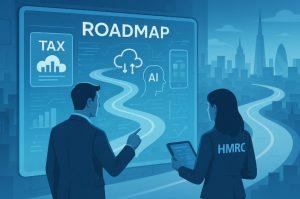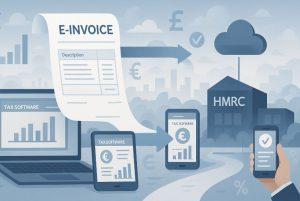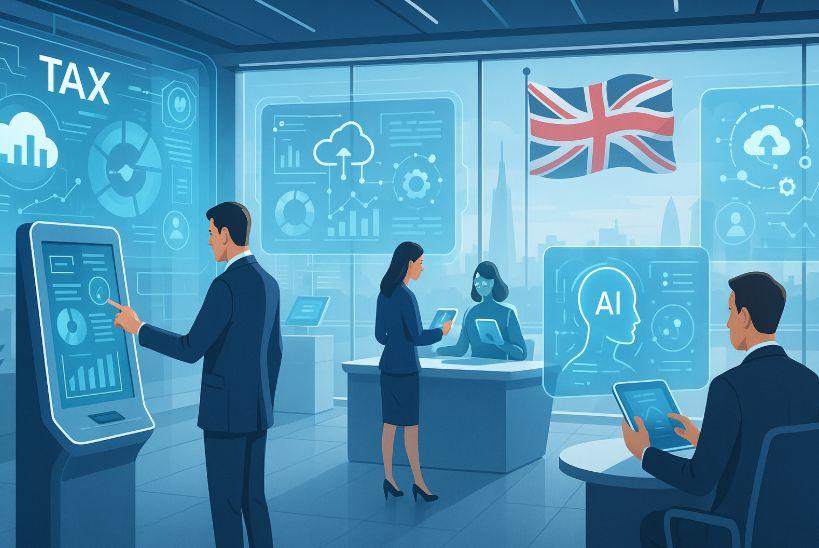As the UK continues to embrace digital governance, one of the most critical overhauls is taking place at Her Majesty’s Revenue and Customs (HMRC).
HMRC’s Transformation Roadmap outlines a forward-looking strategy to digitise and automate the UK’s tax system, aligning it more closely with modern financial practices and setting the stage for a smarter, more efficient tax experience by 2025 and beyond.
In this guide, we explore how this transformation affects taxpayers, businesses, tax advisers, and intermediaries. Drawing directly from the official HMRC roadmap, this blog breaks down each component of the reform and explains its relevance to the UK public, particularly those in London and across the broader business community.
What Is the HMRC Transformation Roadmap?

The HMRC Transformation Roadmap is a long-term digital strategy launched to modernise the UK’s tax and customs system. This initiative is more than an IT upgrade. it is a complete redesign of how tax administration functions across the nation.
By 2030, HMRC aims to become a digital-first tax authority where at least 90% of customer interactions are handled online. The vision includes automation, data-driven compliance, simplification of tax processes, and a focus on real-time services for both individuals and businesses.
What Are the Strategic Objectives of HMRC’s Transformation?
Closing the Tax Gap
One of the primary drivers for the transformation is the need to reduce the £46.8 billion tax gap. Through real-time reporting, enhanced AI risk targeting, and better use of third-party data, HMRC seeks to ensure that tax compliance becomes seamless and less prone to error.
Improving Customer Experience
Taxpayers will benefit from intuitive digital services that make it easier to manage, track, and update their tax records. Features like progress tracking, pre-filled forms, and AI-guided support are aimed at empowering individuals to handle tax affairs independently.
Reform and Modernisation
This includes updates to legislative frameworks, integration of AI, deployment of new platforms, and the replacement of legacy IT systems all of which will increase agility and resilience within the tax infrastructure.
Workforce Development
HMRC is committed to building a high-performing, skilled workforce, equipped with digital and data skills to support the transformation. Over 80,000 training courses were completed in 2024–2025 alone, including 11,000 AI-focused modules.
How Is Making Tax Digital (MTD) Reshaping the System?
Making Tax Digital (MTD) remains central to the roadmap. This government-led initiative is being gradually rolled out across various tax categories, with the ultimate goal of digitising record-keeping and reporting for all taxpayers.
MTD Milestones
Rollout Phase |
Taxpayer Group |
Implementation Date |
| MTD for VAT | All VAT-registered businesses | Fully enforced by 2022 |
| MTD for ITSA (£50k+) | Self-employed & landlords with income > £50,000 | April 2026 |
| MTD for ITSA (£30k–50k) | Self-employed & landlords with income > £30,000 | April 2027 |
| MTD for ITSA (£20k–30k) | Future expansion target | April 2028 (proposed) |
The shift to MTD will mean fewer tax errors, faster updates, and a more transparent system for taxpayers and HMRC alike.
How Are HMRC’s Digital Services Evolving for 2025?

Personal Tax and PAYE Services
HMRC is rolling out a new online PAYE portal, accessible via the Personal Tax Account and HMRC app. This service will allow users to view and edit income details, allowances, and reliefs in real time improving accuracy and reducing calls to helplines.
Self Assessment Improvements
Digital services will be expanded to:
- Simplify the registration and de-registration processes
- Allow direct upload of supporting documentation
- Pre-populate returns with known data, including Child Benefit information (from 2026)
National Insurance Digitalisation
More than 1.5 million individuals have already downloaded their National Insurance numbers to their digital wallets. Enhanced services will support faster processing of voluntary contributions and refunds.
How Will Automation and AI Transform Tax Administration?
Artificial Intelligence is set to revolutionise tax compliance and customer interaction.
Digital Assistants and Smart Nudges
HMRC’s digital assistant, Ask HMRC Online, is becoming more intelligent and capable. It will:
- Interpret natural language queries
- Provide relevant HMRC guidance instantly
- Learn from interactions to improve future responses
AI in Casework and Fraud Prevention
Caseworkers will soon benefit from AI-powered assistants capable of summarising documents, providing regulatory guidance, and automatically classifying tax behaviours. Tools such as voice analytics and automated document verification will help identify and act on fraud more efficiently.
What Are the Implications for Small Businesses and Intermediaries?
Small businesses represent a major segment of the taxpayer population, and they contribute to a significant portion of the tax gap. HMRC is tackling this by simplifying digital access and improving adviser integration.
Digital Partnerships with Agents
New features will enable:
- Multiple tax adviser access for a single client
- Secure three-way communication between agents, HMRC taxpayers
- Real-time tracking of submissions and repayments
Enhanced Agent Services (2025–2027)
Improvement Area |
Description |
|
| Client Withdrawal Function | Agents can remove clients from Self Assessment | |
| Tax Code Impact Reporting | Submit digital updates affecting a client’s tax code | |
| Income Viewer Enhancements | Access richer data on clients’ income records | |
| Agent Escalation Service | Dedicated support for cases unresolved after 4 weeks |
How Is HMRC Improving Access for Digitally Excluded Users?

While HMRC pushes for digital adoption, it recognises that a segment of customers will require traditional support.
Targeted Services Include:
- Telephony Support: Backed by AI to speed up call routing
- Paper Correspondence: Retained for essential communications
- Community Engagement: HMRC continues funding outreach programmes to assist vulnerable populations
Research projects are ongoing to better understand the needs of those in vulnerable situations and to update support strategies accordingly.
What Measures Are in Place to Close the Tax Gap?
HMRC’s approach is threefold: prevention, promotion, and intervention.
Prevention Through Technology
- Pre-populated tax returns
- Digital nudges to guide correct filing
- Automatic registration using third-party data
Promotion Through Education
- Creation of tax education modules for students and small businesses
- Simplified guidance for complex tax areas
Intervention Using AI and Data Analytics
AI tools will flag discrepancies, detect fraud, and support compliance officers with faster decision making. The use of biometric fraud detection and voice analytics will be expanded to streamline compliance checks.
How Is HMRC Reforming Its Internal Infrastructure?
To support its transformation, HMRC is overhauling its IT systems, data sharing protocols, and digital identification tools.
Infrastructure Enhancements
Area |
Planned Upgrade |
| Data Security | Transition to cloud-hosted platforms and secure networks |
| Identity Verification | Rollout of GOV.UK One Login for all HMRC services |
| Cross-Government Integration | Shared APIs and data hubs for seamless services |
| Automation Testing | Use of synthetic data for safe AI experimentation |
What Role Will E-Invoicing and MTD Play in Future Reforms?

E-invoicing and MTD are aligned in their goal to reduce error and improve compliance.
The Case for E-Invoicing
According to global studies, adopting e-invoicing:
- Cuts processing time by 50%
- Reduces late payments by 20%
- Improves financial transparency and reporting accuracy
HMRC, in partnership with the Department for Business and Trade, is exploring policies to encourage or mandate e-invoicing over the coming years.
How Will HMRC Collaborate Across Government and Borders?
The success of tax transformation relies on effective interdepartmental and international cooperation.
Notable Collaborations:
- With DWP to share income data
- With HM Courts to streamline the appeals process
- With US Customs on digital trade credentials
- With OECD and EU partners on crypto and offshore taxation
HMRC also participates in ADR UK and National Data Library initiatives to improve evidence-based policymaking.
How Will HMRC Ensure Ethical Use of AI and Data?
Transparency and security remain paramount in HMRC’s AI and data strategy.
- Adherence to UK government AI and GenAI frameworks
- Continuous ethical review of AI applications
- Public education on how customer data is used and protected
HMRC will also create expectations for third-party software providers to ensure their AI models support compliant outcomes.
What Is the Future of AI and Data Sharing in the UK Tax System?

The use of Artificial Intelligence and cross-government data sharing is accelerating under HMRC’s roadmap but it’s also prompting fresh public interest and questions around privacy, efficiency, and use cases.
By 2030, HMRC will become one of the most data-driven public organisations in the UK, making real-time decisions using:
- Integrated third-party data (from banks, employers, platforms)
- AI-driven case risk analysis
- Predictive tax modelling
Examples of Future Data Use
Feature |
Purpose |
| AI-Powered Fraud Detection | Identifies abnormal filings and high-risk tax returns in real time |
| Predictive Customer Support | Uses AI to suggest help articles or tailored guidance before users ask |
| Secure Interdepartmental Data Sharing | Supports faster ID verification, income reconciliation, and appeals |
| Real-Time Tax Position Dashboards | Offers customers a comprehensive, up-to-date tax snapshot |
These innovations not only streamline taxpayer interactions but also reduce the cost of manual compliance investigations. As data becomes more interconnected, the burden on the individual to report, update, or cross-check information will decrease.
Of course, all of this is being developed under strict UK data protection laws. HMRC is committed to transparency in AI usage and shares information through approved legal gateways only such as with the Office for National Statistics, the Home Office, and international tax authorities.
Conclusion
The HMRC Transformation Roadmap isn’t just about embracing digital services. it’s about redefining the relationship between taxpayers and government. Whether you’re an individual, small business owner, tax agent, or software provider, these changes will have a profound impact on how you manage tax responsibilities.
Adapting early and staying informed will be essential as HMRC continues its journey to becoming a world-class digital tax authority.
Resource:
FAQs About HMRC Transformation Roadmap
What is the primary goal of the transformation roadmap?
To build a more efficient, fair, and modern tax system that benefits individuals, businesses, and government alike.
How will the roadmap impact self-employed individuals?
They will gain access to automated digital services that simplify record-keeping, reduce errors, and enhance transparency.
Will phone and postal services be discontinued?
No. HMRC will retain these services for those who need them, while promoting digital adoption wherever possible.
Is AI replacing HMRC staff?
No. AI will assist staff by handling repetitive tasks, allowing human resources to focus on complex, high-value cases.
How secure is HMRC’s digital platform?
All services meet UK Government Digital Service Standards and include robust encryption and fraud prevention tools.
Will tax agents have better tools to manage clients?
Yes. Agents will have access to more digital features, real-time updates, and secure communication channels with HMRC.
What is the future of MTD for low-income taxpayers?
HMRC aims to extend MTD benefits to taxpayers earning below £20,000 through simplified digital solutions and education tools.









Leave feedback about this